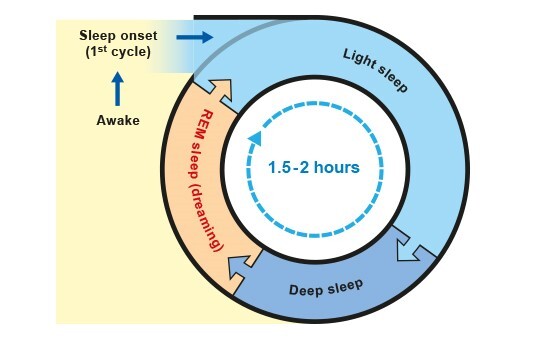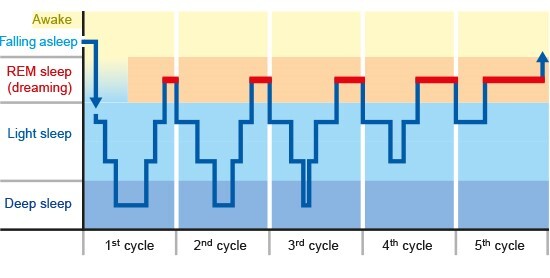NCBI Bookshelf. A service of the National Library of Medicine, National Institutes of Health.
InformedHealth.org [Internet]. Cologne, Germany: Institute for Quality and Efficiency in Health Care (IQWiG); 2006-.
A good night’s sleep is when you fall asleep easily, do not fully wake up during the night, do not wake up too early, and feel refreshed in the morning. Regularly having difficulty falling asleep or trouble sleeping through the night isn't normal for healthy people of any age. But not everyone needs the same amount of sleep, and quality of sleep is different in different phases of life.
For instance, toddlers need to sleep a lot more than older children and adults do. But most children have adult-like sleep patterns by the time they reach the age of five: They are awake during the day and then sleep through the night. The amount of time spent sleeping slowly decreases until the age of about 80.
Young children and older people sleep more lightly than teenagers and adults do. The length of time spent in deep sleep changes over a person's lifetime.

A sleep cycle is made up of different stages
The sleep cycles
Sleep starts when you first fall asleep and ends when you wake up and stay awake, ready to start your day.
It consists of a number of sleep cycles. The cycles usually occur every 90 to 110 minutes. So someone who sleeps eight hours has around five of these cycles. In turn, each cycle is made up of different stages.
There are two main kinds of sleep:
- REM sleep and
- non-REM (NREM) sleep
REM is short for "rapid eye movement." This name describes the quick eye movements that can be observed in sleeping people. In the REM ("dreaming") stage, children's and adults' eyes move back and forth quickly but their eyelids are still closed.
The sleep stages
The period between first falling asleep and entering the next stage of sleep is known as sleep onset. This is a period of very light sleep, where you are drifting in and out of consciousness and are easily woken.
In stage 2, the functioning of the brain slows down but there are still short bursts of activity. This light-sleep stage makes up about half of a total sleep cycle.
Stage 3 is a deep-sleep phase where things like noise don't disturb the person's sleep so easily.
The deep-sleep stage is followed by the REM stage, which is when we dream and our sleep becomes lighter again.
When this stage ends, a new sleep cycle starts. As the night continues, the REM stages become longer and the deep-sleep stages become shorter. Some people completely or partially wake up after a sleep cycle ends, while others stay asleep until morning.

The different stages of sleep repeat in a certain order
Sleep changes as you age
There are plenty of theories about what normal sleep is and how it is affected by age. We know that sleep onset (the time needed to enter into light sleep) increases a little with age. But this age-related difference is very small: Between the ages of 20 and 80, the length of sleep onset increases by less than ten minutes in total.
The REM stages gradually become longer between the ages of 5 and 19. They then stay fairly stable until about the age of 60. People over 60 get slightly less REM sleep, and they don't sleep quite as soundly as younger people do.
For children between the ages of 6 and 12, nine hours of sleep is quite normal. The average person sleeps about seven hours a night around the age of 40, and about six and a half hours a night between the ages of 55 and 60. A healthy 80-year-old will usually sleep about six hours a night. But these are all only averages. Everyone needs a different amount of sleep.
Sources
- Andreae S, Avelini P, Berg M et al. Lexikon der Krankheiten und Untersuchungen. Stuttgart: Thieme; 2008.
- Kasper DL, Fauci AS, Hauser SL et al. Harrison's Principles of Internal Medicine. New York: McGraw-Hill; 2015.
- Pschyrembel Online. 2021.
IQWiG health information is written with the aim of helping people understand the advantages and disadvantages of the main treatment options and health care services.
Because IQWiG is a German institute, some of the information provided here is specific to the German health care system. The suitability of any of the described options in an individual case can be determined by talking to a doctor. informedhealth.org can provide support for talks with doctors and other medical professionals, but cannot replace them. We do not offer individual consultations.
Our information is based on the results of good-quality studies. It is written by a team of health care professionals, scientists and editors, and reviewed by external experts. You can find a detailed description of how our health information is produced and updated in our methods.
- In brief: What is “normal” sleep? - InformedHealth.orgIn brief: What is “normal” sleep? - InformedHealth.org
Your browsing activity is empty.
Activity recording is turned off.
See more...
